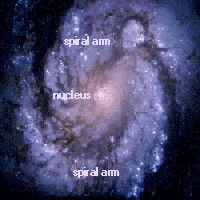|
A. Galaxies
Together, stars, nebulae and clusters occur in gravitationally linked
groupings called galaxies. They vary greatly in size and shape, and range
up to really large galaxies that include hundreds of billions of stars.
The two galactic shapes that are most readily apparent are elliptical
(more or less oval blobs) and spiral (giant pinwheels of stars and
gases). Others, generally small and asymmetric, show little pattern to
their shape and are called irregular galaxies.
Spiral galaxies come in two main varieties, normal spirals, where
the spiral arms extend directly from the nucleus, and barred spirals where
the spiral arms come off a bar of stars that extends from the nucleus.
The Milky Way is a normal spiral (type Sb).
Elliptical galaxies are systems without spiral arms. They vary
in shape from spherical to football-shaped to almost flat, lens-shaped.
Some are dwarf galaxies, some are giants larger than the Milky Way. We
generally think that elliptical galaxies evolved from the collision of
spiral galaxies and one interpretation for irregular galaxies is that they
are pieces of spiral arms that got separated during collisions between
galaxies.
 Our own galaxy,
the Milky Way, is a spiral galaxy, majestically rotating in space.
Over 100,000 light years across it is made up of some 150 billion stars.
The sun takes some 225 million years to revolve around the center of this
galaxy even at its speed of 220 km/s. Hidden from sight behind these spiral
arms is a nearly spherical central nucleus where stars are more
dense than in other parts of the galaxy and at whose center lies a black
hole packing several million solar masses in a volume smaller than the
solar system. Spiral arms radiate outward from this nucleus to form
a flattened disk. Our star, the sun, lies about two thirds out from the
galactic center (some 30,000 LY) in one of these spiral arms (the Orion
arm) and travels among the other stars at 19 km/s (nearly 12 mi/s). Scattered
between the stars that are light years apart in in the spiral arms are
gases (mostly hydrogen and helium) and dust. Extensive clouds of these
materials make up the nebulae. Lying outside the nucleus and the disk are
a few hundred globular clusters. Our own galaxy,
the Milky Way, is a spiral galaxy, majestically rotating in space.
Over 100,000 light years across it is made up of some 150 billion stars.
The sun takes some 225 million years to revolve around the center of this
galaxy even at its speed of 220 km/s. Hidden from sight behind these spiral
arms is a nearly spherical central nucleus where stars are more
dense than in other parts of the galaxy and at whose center lies a black
hole packing several million solar masses in a volume smaller than the
solar system. Spiral arms radiate outward from this nucleus to form
a flattened disk. Our star, the sun, lies about two thirds out from the
galactic center (some 30,000 LY) in one of these spiral arms (the Orion
arm) and travels among the other stars at 19 km/s (nearly 12 mi/s). Scattered
between the stars that are light years apart in in the spiral arms are
gases (mostly hydrogen and helium) and dust. Extensive clouds of these
materials make up the nebulae. Lying outside the nucleus and the disk are
a few hundred globular clusters.
|





